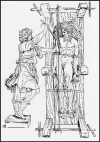Management of fractures of the humerus in Ancient Egypt, Greece, and Rome: an historical review
- PMID: 19002538
- PMCID: PMC2690737
- DOI: 10.1007/s11999-008-0612-x
Management of fractures of the humerus in Ancient Egypt, Greece, and Rome: an historical review
Abstract
Fractures of the humerus have challenged medical practitioners since the beginning of recorded medical history. In the earliest known surgical text, The Edwin Smith Papyrus (copied circa 1600 BC), three cases of humeral fractures were described. Reduction by traction followed by bandaging with linen was recommended. In Corpus Hippocraticum (circa 440-340 BC), the maneuver of reduction was fully described: bandages of linen soaked in cerate and oil were applied followed by splinting after a week. In The Alexandrian School of Medicine (third century BC), shoulder dislocations complicated with fractures of the humerus were mentioned and the author discussed whether the dislocation should be reduced before or after the fracture. Celsus (25 BC-AD 50) distinguished shaft fractures from proximal and distal humeral fractures. He described different fracture patterns, including transverse, oblique, and multifragmented fractures. In Late Antiquity, complications from powerful traction or tight bandaging were described by Paul of Aegina (circa AD 625-690). Illustrations from sixteenth and seventeenth century surgical texts are included to show the ancient methods of reduction and bandaging. The richness of written sources points toward a multifaceted approach to the diagnosis, reduction, and bandaging of humeral fracture in Ancient Egypt, Greece, and Rome.
Figures





Similar articles
-
Management of proximal humeral fractures in the nineteenth century: an historical review of preradiographic sources.Clin Orthop Relat Res. 2011 Apr;469(4):1197-206. doi: 10.1007/s11999-010-1707-8. Epub 2010 Dec 7. Clin Orthop Relat Res. 2011. PMID: 21136221 Free PMC article. Review.
-
Fractures of the proximal humerus.Acta Orthop Suppl. 2013 Oct;84(351):1-32. doi: 10.3109/17453674.2013.826083. Acta Orthop Suppl. 2013. PMID: 24303817
-
[The Edwin Smith papyrus in the history of medicine].Rev Med Chil. 2012 Oct;140(10):1357-62. doi: 10.4067/S0034-98872012001000020. Rev Med Chil. 2012. PMID: 23559298 Spanish.
-
The Edwin Smith Surgical Papyrus.Childs Nerv Syst. 1999 Jul;15(6-7):281-4. doi: 10.1007/s003810050395. Childs Nerv Syst. 1999. PMID: 10461775
-
Hippocrates, Galen, and the uses of trepanation in the ancient classical world.Neurosurg Focus. 2007;23(1):E11. doi: 10.3171/foc.2007.23.1.11. Neurosurg Focus. 2007. PMID: 17961050 Review.
Cited by
-
The history, evolution and basic science of osteotomy techniques.Strategies Trauma Limb Reconstr. 2017 Nov;12(3):169-180. doi: 10.1007/s11751-017-0296-4. Epub 2017 Oct 6. Strategies Trauma Limb Reconstr. 2017. PMID: 28986774 Free PMC article. Review.
-
Humeral shaft fractures.Curr Rev Musculoskelet Med. 2012 Sep;5(3):177-83. doi: 10.1007/s12178-012-9125-z. Curr Rev Musculoskelet Med. 2012. PMID: 22566083 Free PMC article.
-
Orthopedic surgery in ancient Egypt.Acta Orthop. 2014 Dec;85(6):670-6. doi: 10.3109/17453674.2014.950468. Epub 2014 Aug 20. Acta Orthop. 2014. PMID: 25140982 Free PMC article.
-
The Technological Process of Obtaining New Linen Dressings Did Not Cause the Loss of Their Wound-Healing Properties.Materials (Basel). 2021 Dec 15;14(24):7736. doi: 10.3390/ma14247736. Materials (Basel). 2021. PMID: 34947330 Free PMC article.
-
The Orthopedic Splint and Its Origins.Orthop Rev (Pavia). 2025 May 16;17:137673. doi: 10.52965/001c.137673. eCollection 2025. Orthop Rev (Pavia). 2025. PMID: 40384920 Free PMC article.
References
-
- {'text': '', 'ref_index': 1, 'ids': [{'type': 'DOI', 'value': '10.1002/(SICI)1097-0185(199612)246:4<423::AID-AR1>3.0.CO;2-W', 'is_inner': False, 'url': 'https://doi.org/10.1002/(sici)1097-0185(199612)246:4<423::aid-ar1>3.0.co;2-w'}, {'type': 'PubMed', 'value': '8955781', 'is_inner': True, 'url': 'https://pubmed.ncbi.nlm.nih.gov/8955781/'}]}
- Agarwal SC, Grynpas MD. Bone quantity and quality in past populations. Anat Rec. 1996;246:423–432. - PubMed
-
- None
- Allen JP. The Art of Medicine in Ancient Egypt. New York, NY: The Metropolitan Museum of Art; 2005.
-
- {'text': '', 'ref_index': 1, 'ids': [{'type': 'DOI', 'value': '10.1016/0047-2484(72)90023-1', 'is_inner': False, 'url': 'https://doi.org/10.1016/0047-2484(72)90023-1'}]}
- Bourke JB. Trauma and degenerative diseases in ancient Egypt and Nubia. J Hum Evol. 1972;1:225–232.
-
- None
- Breasted JH. The Edwin Smith Surgical Papyrus: Published in Facsimile and Hieroglyphic Transliteration with Translation and Commentary in Two Volumes. Chicago, IL: The University of Chicago Press; 1930.
-
- Celsus. De Medicina. WG Spencer, trans-ed. Cambridge, MA: Harvard University Press; 1938.
Publication types
MeSH terms
LinkOut - more resources
Full Text Sources
Medical

